new posts in all blogs
Viewing: Blog Posts Tagged with: NJ-SCBWI, Most Recent at Top [Help]
Results 1 - 15 of 15
How to use this Page
You are viewing the most recent posts tagged with the words: NJ-SCBWI in the JacketFlap blog reader. What is a tag? Think of a tag as a keyword or category label. Tags can both help you find posts on JacketFlap.com as well as provide an easy way for you to "remember" and classify posts for later recall. Try adding a tag yourself by clicking "Add a tag" below a post's header. Scroll down through the list of Recent Posts in the left column and click on a post title that sounds interesting. You can view all posts from a specific blog by clicking the Blog name in the right column, or you can click a 'More Posts from this Blog' link in any individual post.

It’s NOVEMBER ALREADY?
Well, almost. October will whip by in a sugar-induced haze. Especially because a) I’ll buy candy way too early and eat it all; and b) my kids will change their minds about their Halloween costumes umpteen times. “I wanna be Frankie Stein! No, Draculaura! No, a zombie mermaid! Ooh, I know, a picture book author! I can trick-or-treat in my jammies with a story stuck to my forehead! You’re sorta like a zombie, right, Mommy?”
Um, YEAH.
October is NOT the month of jack-o-lanterns, candy corn (BLECH!) and costumes. It’s the month of PiBoIdMo-eve!
Don’t know what PiBoIdMo is? Check it.
Our 5th anniversary logo, banners and badges have been designed by the kawaii-cutie, author-illustrator Joyce Wan.
Joyce knows my penchant for hot-air balloons. (My husband almost proposed on one. But I think he was afraid I’d drop the ring.)
So this year’s theme is IDEAS TAKING FLIGHT!

WAIT A MINUTE! DID TARA SAY 5TH ANNIVERSARY?!
Yep, I sure did. Which means I’ll have to come up with something super-snazzy for this year. So how ’bout JANE YOLEN?
Besides the legendary Ms. Yolen, here are some of the authors and illustrators who’ll be blogging all November long, helping you to fill your idea notebook with 30 picture book concepts:
- Drew Daywalt
- Michael Garland
- Melissa Guion
- Leeza Hernandez
- Lenore & Daniel Jennewein
- Renee Kurilla
- Elizabeth Rose Stanton
- Adam Lehrhaupt
- Wendy Martin
- The McQueen Brothers
- Pat Miller
- Pat Zietlow Miller
- Anne Marie Pace
- Paul Schmid
- Annette Simon
- Tammi Sauer
- Sudipta Bardhan-Quallen
- Dianne de las Casas
- James Proimos
- Laurie Keller
- Katie Davis
- Zachariah Ohora
- Kelly Light
- Steve Barr
- Greg Pizzoli
And even more to be announced…
Official registration will begin on this blog on OCTOBER 24th and run through NOVEMBER 4th. Watch for it! (It’s easy-peasy-lemon-squeezy if you just follow this blog. See left column.) Only officially registered participants will be eligible for PRIZES, like a consultation with a picture book agent!
But you can grab the “Official Participant” Badge NOW and proudly slap it on your blog or social network site. Kindly link it back to taralazar.com/piboidmo so folks know where to join the challenge. You can also grab the “Ideas Taking Flight!” slogan above.
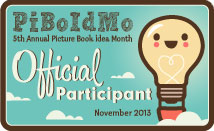
Do you Tweet? Add a PiBoIdMo Twibbon to your Twitter avatar. Just visit the PiBoIdMo 2013 Campaign to upload it.
And here’s some adorbs lightbulb balloons! Use them when you’re blogging about PiBoIdMo to express yourself!







The only thing that’s missing is the PiBoIdMo 2013 merchandise to benefit RIF—like your official idea notebook—so I’ll be announcing that soon.
In the meantime, let us know how YOU’RE gearing up for PiBoIdMo. Blog about it or leave a comment below. What are you looking forward to this November?
Me? Tonight I’m hosting one of NJ-SCBWI’s PiBoIdMo kick-off parties at the Manville Public Library. Maybe I’ll see some of you there? I promise I won’t be a zombie.


You’ve been waiting a long time…but here they finally are: the Mira Reisberg contest winners! I will contact those of you listed here with an exclusive email address to submit to Mira’s Hummmingbird Literary.
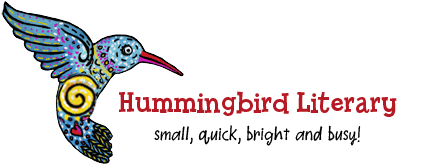
Donna Earnhardt
Mary Uhles
Vivian Kirkfield
Laura Renauld
Angie Karcher
There were SO MANY great marketing suggestions, I wanted to pick EVERYONE. You can imagine why it took me so long. Once again I want to thank the lovely and talented Mira Reisberg for sponsoring this contest, and best wishes to all the winners.
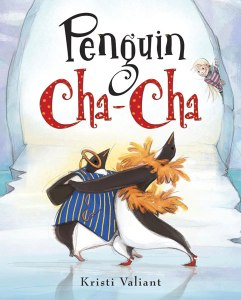
Next, the winner of Kristi Valiant’s PENGUIN CHA-CHA Prize Pack! It’s…
Pam Brunskill!
Be on the lookout for my email, Pam. And congrats!
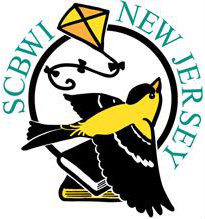
And while I have your attention, NJ-SCBWI just opened registration for a flurry of inspiring and entertaining fall events. I’ll be hosting a PiBoIdMo Kick-Off on October 1st in Manville, plus there’s two other PiBo and NaNoWriMo parties. I’ll also be teaching a picture book workshop at the Fall Craft Weekend on November 10th.
Check it all out at NJSCBWI.com and click “follow blog” so you don’t miss any future event announcements!
Happy writing to everyone! And stay tuned…some PiBoIdMo announcements are coming soon!


This is the fourth in a series of posts about the NJ-SCBWI Annual Conference. Visit all this week for insights from this first-class children’s book writing event.
…continued from previous post…
Kate’s final piece of contradictory advice—listen to what others say; don’t listen—was demonstrated by a conversation between Kate and her agent, Holly McGhee.
Kate finished a picture book manuscript and sent it off to Holly. The conversation began with Holly:
“No.”
Kate didn’t understand. “Huh?”
“No.” Holly repeated.
“But why?”
“I don’t care about the main character.” Holly didn’t even think it was a picture book. “This is a novel,” she said.
Slowly Kate realized that Holly was right. Kate wanted to write a picture book but a picture book is not what emerged. Deep down, she knew it was something more, but darn it, she wanted it to be a picture book. She was trying to get away with something, but Holly caught her.
Kate then circled back to the time after she had released THE TIGER RISING and BECAUSE OF WINN-DIXIE, two southern novels. She received many accolades. People loved her work.
So she began to write another “novel set in the south about nothing really at all,” like her two previous books. Once people loved her work, she felt compelled to continue along the same vein. She wanted everyone to keep loving her. But what was coming out was not genuine. The love and joy and play in her writing was gone. She was forcing herself to create something she did not want to write. And all to please everyone else, not herself. (Remember contradiction #2?)
Instead, she began a fairytale about a princess and a mouse. She showed it to a trusted friend. The response? “It’s not what you do best.”
Again, people expected her to write a southern novel.
But she pressed on. The princess and mouse was where her heart led her, and that is where she would remain. “Damn the torpedoes, full steam ahead!”
Damning those torpedoes was an excellent decision, for THE TALE OF DESPEREAUX won the Newbery.
In the end, Kate DiCamillo assured us that a life of a writer can be “terrible beyond all imagining, but it will be okay.” Another contradiction. We know this business is tough, but we still choose to write because we can’t NOT write.
I, for one, will try to embrace the terror from now on, because that’s what writing is—being in the depths of the unknown and yet in a constant state of discovery. The final contradiction.






![]()
This is the second in a series of posts about the NJ-SCBWI Annual Conference. Visit all this week for insights from this incredible children’s book writing event.
…continued from previous post…
After seven years, Kate decided she wanted to live a life in which she was always making art. She had fear as a writer, especially in revision, but instead of the terror paralyzing her any longer, it motivated her.
Kate introduced writing’s first contradiction: “you go on a long journey but stay in the same place.” The writing can take you anywhere, but you are still a lonely writer sitting at a keyboard.
Kate explained that a career in writing means you have to “chart a course through the contradictions.” She revealed five pieces of contradictory writing truths:
- Be absolutely rigid; Be loosey-goosey.
- Write only for others; Write only for yourself.
- Hide yourself; Reveal yourself.
- Compromise; Never compromise.
- Listen to what other people say; Don’t listen.
Kate had a good friend Oscar during that not-writing-but-wanting-to-be-a-writer seven-year stretch. One day they discussed belief in miracles and Kate told Oscar that she wanted to be a writer.
“Baby, that don’t take a miracle. That’s all on you,” Oscar said.
She had never realized that the whole of the task was on her. You have to do what you promise yourself. After years of brooding, she came to know that it was “easier to do the work than to NOT do the work.” Just in case we didn’t get it, she repeated this several times.
Yes, art and fear always go together. The constant feeling of uncertainty creates a tolerance for uncertainty. In other words, embrace the terror. It’s a prerequisite for success.
As I sat in the balcony, I had my own epiphany. Writing picture books is my comfort zone. My middle grade novel has been sitting untouched for more time than I’m willing to reveal. And it’s languishing out of pure fear: fear of ruining what I already adore, fear of not knowing what comes next, fear of writing more than 600 words IN A ROW. Why have I not embraced the fear before? Kate DiCamillo says she never works with an outline; “an outline kills it.” She writes to know what happens next. And that’s how I write, too. I enjoy discovering the story as I write. But I thought writing a novel like that was WRONG. Now I understand that nothing is wrong, it’s just the way I like to work.
So when Kate says “be absolutely rigid”, she means to commit yourself to the work. But when she contradicts this advice with “be loosey-goosey” she means the stories want love and joy and play. Go ahead and write without an outline, don’t plot where you’re going and you’ll journey somewhere totally unexpected. She equates this first contradiction with standing at a door and knocking. You must stand there, but how you knock is up to you. Shave and a haircut? A rock riff? Gentle tapping? How will you knock?
…to be continued…




This is the first post in a series about the NJ-SCBWI Annual Conference, held in Princeton, NJ this past weekend, June 8-10. Visit all this week for insights from this stellar children’s book writing event.

My daughter with Kate DiCamillo
Kate DiCamillo began her NJ-SCBWI keynote speech warning us that is was long and full of contradictory advice. I am certain no one minded. I mean, if you have an opportunity to hear Kate speak, wouldn’t you want it to last forever?
After college, Kate’s family asked, “So what are you going to do now?” Of course, the answer was simple: “I’m going to be a writer.” Simple and yet complicated—again, a contradiction. She didn’t have any desire to actually write, she just wanted to be a writer.
Instead, she worked in a greenhouse and came home with dirt crusted under her fingernails. Her mother would ask how her day went. “I’m a manual laborer!” Kate would yell. “How do you think my day went?!” Then she’d storm to her bedroom and slam the door.
After a few minutes, her mother would knock gently. “What are you doing now?” she’d ask.
“I’m writing,” Kate would answer. But Kate wasn’t writing, she was just sitting on her bed.
“I don’t hear anything,” responded her mother.
So Kate would turn on the typewriter with its gentle hum. “There! Are you happy now?”
But she let the typewriter hum away and sat on her bed, reading. The book that changed her life? It was THE ACCIDENTAL TOURIST by Anne Tyler. One scene with Macon and Muriel lying in bed struck her:
“Just put your hand here [Muriel's caesarian scar]. I’m scarred, too. We’re all scarred. You are not the only one.”
Those words made Kate want to get up off the bed and work that same magic. Those words transformed—they were broken-hearted but they also healed. Again, a contradiction. But one that Kate could not ignore.
So she began to look around her room. She watched the curtains flutter in the breeze and she noticed how their shadows looked like wings. She began to imagine a story about a woman who was paralyzed, lying motionless in bed, but staring at the same curtains and imagining how they could lift her up.
Kate began to write. Everything else disappeared. “It was like I was playing a piece of music I already knew, as if my fingers knew exactly what to do.”
But as soon as she realized her own dreary reality—a girl alone, sitting at a typewriter, she thought “wait—I can’t do this.” And she stopped writing.
The scary thing is that she realized this was the work she was meant to do. And the fear of that epiphany paralyzed her. She didn’t write for another seven years…
…to be continued…





By:
Tara Lazar,
on 4/10/2012
Blog:
Tara Lazar
(
Login to Add to MyJacketFlap)
JacketFlap tags:
Ame Dyckman,
BOY + BOT,
Contest,
Children's Books,
KidLit,
Robots,
Friendship,
Picture Books,
book giveaway,
Random House,
Children's Writing,
Author Interview,
Writing for Children,
Knopf,
NJ-SCBWI,
dan yaccarino,
Add a tag
 I am so absolutely thrilled that BOY + BOT releases today because I’ve been waiting for it for a long, long time.
I am so absolutely thrilled that BOY + BOT releases today because I’ve been waiting for it for a long, long time.
It’s the debut picture book by my good friend, Ame Dyckman—and get this—it’s illustrated by the hugely talented Dan Yaccarino! I mean, this has got to be the best picture book EVER with an author-illustrator team just as lovable as Boy and Bot themselves.
And for this very special day, I’ve got prizes to give away! One AFFIRMATIVELY AWESOME prize pack including BOY + BOT, stickers, bookmarks, and an *exclusive* BOT keychain clip made by author-zoologist-educator-sculptor Jess Keating!
So let’s get on with the fun!

TL: So, Ame, you and I have been friends for a few years now, after meeting at NJ-SCBWI first page sessions. (I knew I had to get to know you, with your spiky pink hair and Lego bracelet.) Is that how you began your kidlit career, attending SCBWI events?
AD: *laughing* Was my hair pink back then? I don’t remember my hair color at the time (it’s blue, now), but I remember thinking, “Wow! This Tara person is funny and nice and she really knows her kidlit! I like her!” BAM! Friends!
And yes, attending SCBWI events–YAY, NJ SCBWI!–started everything for me! When I first joined, I knew I wanted to write picture books, but I didn’t know how. My first manuscripts were REALLY bad, but nobody made fun of me. Everybody was helpful. (YOU taught me how to page a PB, remember? I still have your diagram!) I went to as many events as I could—First Page Sessions, Mentoring Workshops, Networking Dinners, Annual Conferences, etc. I learned tons—still do!—and met lots of amazing industry professionals and made lots of wonderful friends. At the 2009 NJ SCBWI Annual Conference, I pitched BOY + BOT to Super Agent Scott Treimel, and he said, “I love it! Let’s work together!”
TL: I distinctly remember the 2009 conference and a certain editor making goo-goo eyes at you during lunch…but he had read your manuscript and was bonkers over BOY + BOT. I thought to myself, GO AME! You could feel the buzz about that manuscript at the event. You were in deep conversation with several agents.
So we want to know—how did this beep-worthy book idea come about?
AD: The short answer: I love robots! (I used to doodle robots instead of doing my math homework. Even in college!) The long answer: I love robots and unusual friendship stories and mirror stories always make me laugh, so I hoped mine would make other people laugh, too.
TL: So BOY + BOT is your debut and it has something like 347 starred industry reviews! Are you thrilled or what?
AD: I’m SO happy, and really grateful for all the reviewer love. Here’s hoping the little Boys (and Girls!) and Bots that Dan and I made the book for love it, too!
TL: We’re chatting on the eve of your book’s release. Will you be able to sleep tonight? It’s a little like Christmas Eve, isn’t it?
AD: It feels like Christmas Eve and Birthday Eve and Leaving-for-Disney-World-Tomorrow Eve all smooshed together! I was up until 3:45 this morning because I was so excited already! (But, I think I’d better try to

By:
Tara Lazar,
on 4/9/2012
Blog:
Tara Lazar
(
Login to Add to MyJacketFlap)
JacketFlap tags:
Creative Writing,
Children's Writing,
Writing for Children,
Writing for Teens,
Writing Conference,
NJ-SCBWI,
Ryan Gosling,
RUCCL 2012,
New Jersey,
Add a tag
In 2008, I had the most nerve-wracking 20-minute drive of my life. My knuckles paled, my stomach gurgled, and my thoughts raced faster than the 35 MPH I could manage to clock on the highway. I was on my way to my first kidlit conference ever: the Rutgers University Council on Children’s Literature One-on-One Conference. AHHHH! Somebody help me!
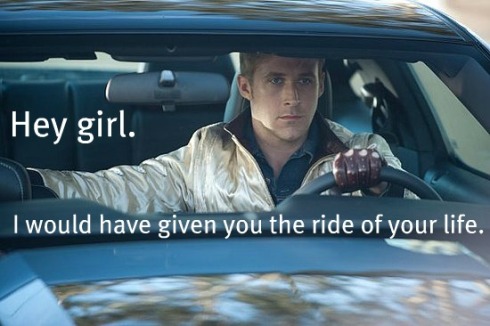
Thanks, Ryan. I know you would have, honey. But I digress…
I knew practically nada about writing for kids. I had slipped the first three pages of my middle grade novel into an envelope earlier that summer and waited patiently for the response. Thankfully, I was on vacation for two weeks of the final countdown. It made my vacation go by much more slowly. I recommend this tactic to anyone who needs to wait—go to a beach, plop a lounge chair in the sand, facing the ocean. Or facing Ryan Gosling in surfing trunks.
But when the vacation was over and the car hit our driveway, I jumped out and dashed to the post office. Awaiting me was a thick envelope, and remembering the drill from college admissions, I knew this meant a “yes”!
So off I went. I was so green. (Although I wore a cute purple top.) But when the event was done, I blogged all about it. Hopefully my notes help prepare you for this year’s conference. You can review them all here: RUCCL 2008.
But Tara, what does this all mean?
It means that the RUCCL 2012 Application is now available!
And guess who’s your morning “Success Story” speaker?
As Miss Piggy would say, “MOI!”
Yeah, I was pretty floored they asked me. Trinka Hakes Noble sent me an email saying, “I hope you don’t mind, but I put your name forward as our Inspiration Speaker for the mentee breakfast. Would you be interested?”
Would I be interested? Are you kidding? Of course I am! Wow! Whoopee! Holy macaroni! Keeno Yaccarino!
Wait a second, what did I just agree to…? Pale knuckles and gurgling stomach again?
Well, I am hoping many of my blog readers will be accepted to the conference this year. Because not only do I want to see you succeed, I’ll need your help during my presentation. (Details to come. No, you won’t need to hold a barf bucket. Well, maybe. OK, don’t quote me on that.)
So polish up those manuscripts! You’ve got until July 2 to postmark them.
And if you have any questions about the conference, please ask away in the comments!




 10 Comments on Rutgers University Council on Children’s Literature One-on-One Conference 2012, last added: 4/9/2012
10 Comments on Rutgers University Council on Children’s Literature One-on-One Conference 2012, last added: 4/9/2012
 Joyce Wan, talented author/illustrator of “Greetings from Kiwi and Pear,” stops by the blog today to recap the recent NJ-SCBWI annual conference. I couldn’t attend this year so Joyce offered to share the juicy details. (Get it? Kiwi and pear…juicy? Ugh, stick to humor in picture books, Tara.)
Joyce Wan, talented author/illustrator of “Greetings from Kiwi and Pear,” stops by the blog today to recap the recent NJ-SCBWI annual conference. I couldn’t attend this year so Joyce offered to share the juicy details. (Get it? Kiwi and pear…juicy? Ugh, stick to humor in picture books, Tara.)
Take it away, Joyce!
It was my first time attending the New Jersey SCBWI Annual Conference and it was such a blast! There were intensives, workshops, lunches with editors/agents/art directors, a book fair, a juried art show, a raffle, auctions, one-on-one critiques, agent pitch sessions and portfolio reviews galore. A whopping 22 publishing houses/agents were represented. A round of applause to Kathy Temean (NJ-SCBWI RA), Laurie Wallmark (Assistant RA) and all the volunteers for coordinating such an amazing and well-organized event. The conference was informational yet inspiring and I left Princeton feeling excited and energized!
Highlights from two of the workshops I attended which stood out in my mind:
Sure it’s Cute, But Will it Sell?
Steve Meltzer
Associate Publisher/Executive Managing Editor, Dial, Dutton, & Celebra
He provided us with information on the business side of the industry and a snapshot of the current picture book market. The market is made up of four types of buyers:
- Independent Retailers
- Mass Market Retailers
- Institutional (Libraries and Schools)
- Book Clubs/Fairs
You want to write a book that hits ALL markets. Examples of current books that are hitting all markets:
- Skippyjon Jones
- Fancy Nancy
- Ladybug Girl
- Llama Llama Red Pajama
As mentioned in the recent #pblitchat on Twitter, Meltzer is looking for character-driven stories: stories with quirky characters that are unusual and original but realistic. Character stories invite sequels, branding, and licensing opportunities.
Picture Books – What Works
Sudipta Bardhan-Quallen
Author of 13 picture books and seven non-fiction books
Picture books should be 650 words or less. Story should consist of a character that has a conflict and makes three failed attempts to solve the problem and then has a successful attempt on the fourth try. The end of the book must surprise the reader (a twist), extending the story beyond the story, which makes the book re-readable. Although she did mention that there are no hard and fast rules to picture book writing–and that these are just what, in her experience, has worked for her–I do think it’s a handy little formula to follow for those of us beginning our journey in the world of picture books! Another little trick that can help add tension to any story is to add a ticking clock of some sort: the character has to reach the goal but also by a certain time (ex. by bedtime, by sundown, etc.).
In addition to the workshops, there were two really inspiring keynote presentations at the lunches given on the first day by David L. Harrison, author of 80 children’s books, and on the second day by Catherine Gilbert Murdock, author of
 Ever have one of those light-bulb moments when your manuscript finally gels? Your plot falls into place and you wonder why you didn’t think of something so simple and perfect before.
Ever have one of those light-bulb moments when your manuscript finally gels? Your plot falls into place and you wonder why you didn’t think of something so simple and perfect before.
Sitting in on Sudipta Bardhan Quallen’s picture book workshop last month, I had a dozen lightbulb moments. She dissected picture book structure like a biology teacher dissecting a frog–she split it wide open and showed us its heart. (OK, maybe that analogy wasn’t good for the squeamish, but she has a science background, so I think it works.)
For example, she suggested inserting a “ticking clock” into our manuscript. A deadline makes the story urgent and exciting. (Eureka!) If you’ve never heard her speak, you’re missing out on one of the finest picture book tutorials anywhere.
Besides being wicked sharp, Sudipta has a nervous energy that’s endearing. Get her engaged in conversation, and she’ll talk non-stop about her love of children’s literature. (And high heels and shopping on Bluefly. Yes, she’s a girly-girl like me.)
Surprisingly, she never dreamed of becoming a kidlit writer. She’d thought of being a doctor (but she’s afraid of blood), a model (but she likes to eat), and the President (but she had a dissolute youth). So much for childhood dreams.
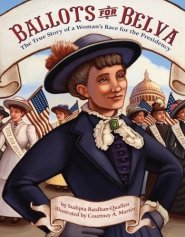 She’s the author of 11 picture books and 16 non-fiction books for children including The Hog Prince (Dutton), Ballots for Belva (Abrams) and Tightrope Poppy the High-Wire Pig (Sterling).
She’s the author of 11 picture books and 16 non-fiction books for children including The Hog Prince (Dutton), Ballots for Belva (Abrams) and Tightrope Poppy the High-Wire Pig (Sterling).
So Sudipta, if you didn’t want to be a writer, how did you get into the kidlit business?
I got pregnant twice in the span of 15 months and had to move from California (where I’d been going to grad school) to New Jersey (where a little piece of me dies every day). Like every other new mom in the world, I decided I had stories that I just had to tell my kids and so I started writing. I also had this idea that writing was totally a job I could do with two babies in the house, which was just stupid because you can’t do anything with two babies in the house.
Amen to that! I can’t do anything with two babies out of the house, either. (And by the way, I’ll let that NJ crack slide.)
When I started writing, everything was really bad. Some day, when I am super-famous, I will pull out my Alphabet book, and my going-to-the-zoo book, and all the other requisite bad stories we all write when we start. But eventually, I figured out to go to conferences and read up on the craft of writing, and I started to get things published.
How did you get your first big break?
About two months after I started writing, I wrote up a short story for Highlights. It was something that had actually happened to a friend of mine, with a bit of fictional dramatization. Highlights bought it and it was the first $200 I made writing.
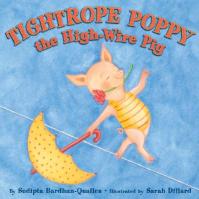 I also randomly got a foot in the door of children’s publishing by mentioning my science background in a cover letter. I’d sent a picture book manuscript to Sterling, which they rejected, but in the rejection the editor asked if I’d consider writing a science experiment book for them. That became Championship Science Fair Projects, which still sells really well for me, and a few years later, my first picture book, Tightrope Poppy, was published by the same editor.
I also randomly got a foot in the door of children’s publishing by mentioning my science background in a cover letter. I’d sent a picture book manuscript to Sterling, which they rejected, but in the rejection the editor asked if I’d consider writing a science experiment book for them. That became Championship Science Fair Projects, which still sells really well for me, and a few years later, my first picture book, Tightrope Poppy, was published by the same editor.
New writers are often told not to mention irrelevant information in queries, but your science background landed you a contract. What exactly is your science background?
I graduated Caltech in 1998 with a BS in Biology (by the way, with the passage of years and my gradual failure to remember even the most basic biology concepts, BS is becoming more and more appropriate). I spent a year at Harvard, but it really wasn’t for me, and then headed back to Caltech as a PhD candidate in developmental neurobiology. But those plans went off the rails when I had two babies. I had this crazy idea that I could write with two kids in the house—which you totally cannot do—but that’s how I got into the writing-for-kids business.
Normally, I recommend that you don’t mention anything other than kidlit in your cover/query letters, but if you keep it short and sweet, you can throw some things in there. I think the line I wrote was something like: “I have a Master’s degree in Biology from the California Institute of Technology and have published several scientific articles.” That doesn’t take up so much space that it is annoying.
What has surprised you most about being a published author?
So many things have surprised me about being a published author. Hard to pick just one. So I wrote a Top Ten list. I love Top Ten Lists. Except after I start writing and realize that I only have six interesting things to say. But who’s ever heard of a Top Six list?
Top Ten surprising things about being a published author:
- That the advances are so small that after everyone has had their cut and you’ve paid all your expenses (whether it’s permissions, or research costs, or just the cost of babysitting that allowed you to write the book) you have just enough money left over to take your family out to dinner. But only if they agree to go Dutch.
- That you can’t just show up at a book store and expect them to have your book. Or believe that you are a real author.
- That there’s a 50-50 chance that the number of kids that are biologically related to you who show up for a book signing will outnumber the number of kids that are NOT biologically related to you.
- That no matter how much market research you’ve done, there’s a good possibility that there is a really similar book out there that no one has ever heard of – except the person writing the review.
- That even though the publisher picks up the tab for producing the book, all of the marketing responsibility is on you. So if you want anyone beyond your mother and your best friend to know about it, you need to get your butt in gear.
- That you know no more about writing or publishing after the contract than you did before. Even though everyone expects that you do.
- That the more successful you get and the more books you publish, the less of your writing time will actually be devoted to writing.
- That when you and a group of writing colleagues meet certain editors (who may now be agents…), no matter how many books you’ve done, the first comment he will make is, “So… you all are *moms*, huh?”
- That it is a long time before you move “real author” into the list of things you consider yourself. I still haven’t really gotten there.
- That going to a school for an author visit is as close to being Angelina Jolie as you will ever get. And it’s a pretty cool feeling.
How did you begin to bill yourself as a speaker?
I started to volunteer to speak at conferences because I wanted to teach what I had learned about the craft of writing picture books to other aspiring writers. I got a lot out of SCBWI events in New Jersey, and I wanted to give back. Also, teaching helps you learn in ways that doing does not. For example, at this year’s NJ-SCBWI annual conference, I gave a workshop about rhythm, rhyme, and repetition. I talked about using a refrain in your picture book manuscript to give it narrative structure—and it was the first time I had consciously realized that that was something I do a lot in my own writing. Having to teach it, however, was what made me conscious of it.
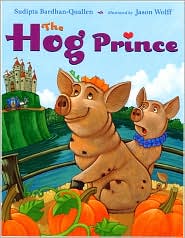 Some authors say they learn something about themselves with each new book. What did writing The Hog Prince teach you?
Some authors say they learn something about themselves with each new book. What did writing The Hog Prince teach you?
In my workshops, I emphasize the importance of the market over and over again. I’m constantly saying that I only write what I know I can sell. But as I review my own body of work, which has finally grown large enough that I feel comfortable calling it a body of work, I notice that, within the confines of what I feel the market can bear, there are themes that I subconsciously explore time and again. And these are the themes that resonate most strongly for me.
In The Hog Prince, Eldon dreams of being something he is not. He believes that if he were to change by magic, his life would be better, that everything would be shiny and pretty and luxurious and grand. And while I run the risk of coming off as having no self-esteem at all (which is not true, I have an itty-bitty bit), I can say that there have been plenty of times in my life that I have felt this way. In fact, I don’t think it is just a childhood thing–I’m not sure that we ever completely grow out of feeling like everything about our lives would be improved if only we could change ONE little thing. Except that it is never a little thing, nor is it one thing, nor will your life actually get better.
What’s nice about the story is that Eldon figures out that he is worthy and precious just the way he is, and that the folks who really matter (in his case, Petunia) don’t want him to change one muddy little thing. I struggle with this lesson, and I think a lot of kids do, too. Hopefully, that’s what makes the story timeless.
So, here is what I learned about myself:
- I sometimes wish I could change into royalty;
- I use my books to sort out emotional issues;
- I think that every story is better is you replace the main character with a pig.
You may be right there. I mean, who doesn’t love pigs? I mean pigs in literature. Real pigs, not so much.
Thanks for the interview, Sudipta! I think I know what the blog market can bear, and although I’d love to talk to you for another thousand words, something’s telling me to wrap it up here.
More of Sudipta’s serious-yet-sassy picture book philosophies can be found on her new blog, including a picture book writer’s Ten Commandments. Thou shalt not submit a manuscript before its time…






Want to be a fly on the wall in an agent’s office? If you were at the NJ-SCBWI conference last week, you got that kind of insider buzz. Some top agents in children’s publishing revealed what’s been sitting on their desks, and more importantly, what hasn’t been submitted.
The agent panel featured:
After brief introductions, the agents welcomed questions. The first attendee (OK, me) wanted to know: “What trends are you seeing in your submissions? Specifically, what are you seeing too often? And what aren’t you seeing?”
The agents were quick to say that vampires were overdone. They’re seeing a lot of fantasy, especially with werewolves and zombies–on their own but also vampire/werewolf/zombie hybrids.
Jill Corcoran added, “I’m seeing a lot of plot-driven manuscripts, but where the character isn’t fully developed.”
The agents thought that paranormal hadn’t yet peaked, while historicals were down. That’s not to say a fantastic historical couldn’t come along and raise the whole genre, but as of now, they weren’t selling well.
They also added, “please don’t send anything about bullies. We’re sick of bullies.” Seems there was a bully article in a prominent parenting magazine (or perhaps it was an Oprah episode?) that began an unwelcomed trend.
Turning their attention to what wasn’t being submitted, Marietta Zacker said, “We’re not seeing a true depiction and representation of our diverse population. Kids aren’t seeing themselves in books and that’s a problem.”
Rachel Orr said, “And please realize there should be other Chinese stories than those about Chinese New Year. And stories about African-Americans that are about something other than slavery.”
Scott Treimel added, “Don’t send a story about three characters from three different races that have adventures.” He said such stories tended to be stereotypical and poorly conceived.
Ms. Zacker emphasized, “Certainly, be true to your voice. But write outside of yourself. Look beyond yourself to the world around you.”
Rachel Orr commented that she sees stories about a kid who moves to a new house far too often.
Scott Treimel wondered, “Where are the stories about the boys who feel weird about their sexuality? What if the girl is aggressive for a change?”
The agents agreed that in regards to sex in YA novels, the sky’s the limit, but it must be organic to the story. Don’t be shocking just for shock’s sake.
An attendee asked if they had been rejected by an agent, but spent several months polishing the manuscript, is it acceptable to submit again?
The agents said that the writer should first look to the agent for a response. Typically, they’ll note if they want to see a revision. And a writer must put the work in before coming back a second time. Marietta Zacker said, “This sounds like common sense, but don’t forget that we remember you. Don’t make us feel like we don’t know you. Please say, ‘I sent this to you six months ago but I’ve revised it…’”
Emily van Beek chimed in with: “Remember that the world owes you nothing. You owe the world your best work.”
In regards to working with an agent, the agents said that their business is all about relationships and trust. “We’re partners in your career. We’re architects for your career. We have a design for you.”
Also remember that an agent has their favorite editors so they’re tuned to the tastes of a few dozen editors, but not all of them. It pays to shop your work around to find the best match.
When the agents were asked what they’re currently working on, books they’re excited about, Marietta Zacker said they are asked this question frequently, “but we always shoot ourselves in the foot when we answer that question. We don’t want to pigeonhole ourselves. You shouldn’t necessarily send to us just because we liked something in particular. And we don’t want you to write to that preference, either.” Agents have a wide range of tastes. “We don’t know we want it until we read it.”
Emily van Beek talked about the importance of falling in love with a manuscript in order to represent it because they do all work on spec. “We don’t get paid until we sell it.” So her mantra tends to be, “If you can resist it, do. I know that sounds [harsh], but it’s true.” She finds projects she can’t live without. Then she has the passion to sell it.
Interestingly, she told us that Kathi Appelt’s Newbery honor The Underneath took two years and underwent eight major revisions.
Scott Treimel added, “Writing and revising are equally important skills.”
Some agents will help edit your manuscript for submission, others may not be that involved. It depends upon the agent. But remember that your agent is not a critique group. Be sure that you have reliable crit partners and that your manuscript is “polished to within an inch of its life” prior to submission.
So when does an agent know that the manuscript is ready to be submitted to editors? When do they let go? Jill Corcoran said, “When I think it’s phenomenal.”
And to end the panel, Jill Corcoran talked about endings. “I love endings that are expected, but unexpected; surprising but logical.”
And I suppose this is a logical place to end this post. Be sure to check back for more from the conference throughout this week!






 “For all those who thought E.B. White was coming. Sorry, I’m the black one. As you can see, I’m not white and I’m not dead.”
“For all those who thought E.B. White was coming. Sorry, I’m the black one. As you can see, I’m not white and I’m not dead.”
Talented artist and illustrator E.B. Lewis discussed process versus product for his NJ-SCBWI keynote. He opened with some humor but then got to serious business.
He has a strong work ethic and told the audience that a person was only an artist if they spent each day producing art. It takes no less than 10,000 hours to become an expert in your craft. If you’re counting, that’s nearly 5 years straight of 40-hour work weeks, no breaks, no vacation.
Work is just that–work. It shouldn’t be easy. But you should love the work. If you don’t, then maybe you’re just fooling yourself into believing you’re something you’re not. Some people say they don’t have the inspiration. “I don’t understand that. I can’t step out of my bed without falling over a juicy piece of inspiration.” (Note to Mr. Lewis: I’m the one who tripped over your portfolio case. How’s that for falling over juicy inspiration?)
Mr. Lewis claims that once he finishes a painting, he admires it. He loves it–for about two hours. Then he hates it. For him, it’s all about the process of creating. He isn’t happy until he is creating once again, improving upon his last accomplishment, trying something new. “As soon as an artist knows their style, they’re dead in the water,” he said. Because your style is something that should be evolving. You’ve got to work hard, you’ve got to better yourself. If you’re satisfied, perhaps you aren’t a true artist.
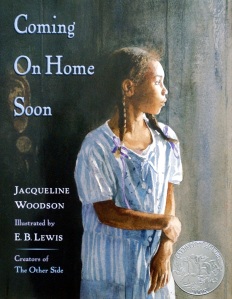 He gave us some background on his childhood. “When I visit schools, I tell the kids that I failed 3rd grade. It levels the playing field. ‘Wow, E.B. Lewis failed!’ the kids say.” The children immediately understand that if Mr. Lewis was able to become an artist, they, too, can reach their goals.
He gave us some background on his childhood. “When I visit schools, I tell the kids that I failed 3rd grade. It levels the playing field. ‘Wow, E.B. Lewis failed!’ the kids say.” The children immediately understand that if Mr. Lewis was able to become an artist, they, too, can reach their goals.
Mr. Lewis attended a small, old school with fireplaces in every classroom. One day during math class, he crawled up the fireplace. Remember how the girl in A Christmas Story pointed shyly toward Flick, outside, tongue frozen to the flagpole? Well, the whole class pointed shyly up the fireplace when the teacher asked where Earl had gone.
Then on career day, a classmate said he wanted to become a doctor. That boy received a lot of attention. E.B. wanted that same kind of attention, so he raised his hand. His teacher pushed it down. He raised it again. Finally, he was able to answer. “I want to be a lawyer,” he said, not because he really wanted to, but because he thought everyone would admire his aspirations. Instead, they all laughed, including the teachers. No one thought E.B. Lewis would amount to anything.
So E.B.’s uncle decided to take a special interest in his nephew. Every Saturday afternoon for years, his uncle drove him to art class because he knew E.B. loved to draw. His uncle told him that artists were the critical thinkers of society, and very well read, so he gave E.B. a new book to read every week. This man connected E.B. Lewis to his passion.
E.B. began his career as a fine artist. He would take photographs of his subjects, but from far away, hidden, with a telephoto lens, because as soon as someone knows their picture is being taken, they no longer act naturally. They’re no longer in the moment.
His work appeared on the cover of a magazine and a few days later he got a call from someone in the children’s book industry, asking if he’d like to illustrate a book. He said no. Why not? “Because I’m a fine artist, not an illustrator.”
What’s the difference? A fine artist solves their own philosophical problem. An illustrator solves someone else’s problem.
However, that art director was persistent and encouraged E.B. to go to the children’s section of the library. Mr. Lewis soon realized that some of the most ground-breaking artistic work was being published in children’s books. He called back and agreed to illustrate.
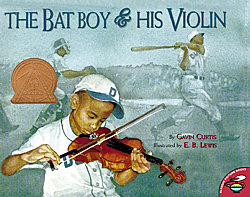 Over the past 14 years, Mr. Lewis has illustrated 47 books at the rate of about 3/4 books a year. He has won the Coretta Scott King illustrator award four times. He won a Caldecott honor for Coming on Home Soon. He works with 14 different publishers and is currently booked through 2014. (That’s right, five years in advance. But I’m taking special note of the lucky number 14.)
Over the past 14 years, Mr. Lewis has illustrated 47 books at the rate of about 3/4 books a year. He has won the Coretta Scott King illustrator award four times. He won a Caldecott honor for Coming on Home Soon. He works with 14 different publishers and is currently booked through 2014. (That’s right, five years in advance. But I’m taking special note of the lucky number 14.)
He is one of the few illustrators who travels to meet with his editor and art department to discuss a book at the early stages. He likes to create a brain trust in the beginning. He starts with thumbnail sketches and this begins the dialogue. Then he enlarges the sketches to a dummy and adds the words. He researches photos in the library and uses a model, often combining both photographic guides to create the end result.
“I have a love of the process, the doing. For me, that’s all there is.”
How lucky for us. We get to enjoy the fruits of his labor.






Thirty-eight agents, editors, art directors and acclaimed authors. Two days. Twenty workshop sessions. The NJ-SCBWI is one little conference that packs a writing wallop.
Over the next few days, I’ll share notes from the event, from my own journal and that of writer Natisha LaPierre. So even if you weren’t there, it will feel like you were. (Just surround yourself with friendly folks passionate about children’s books while you read.)
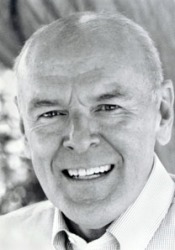 The first keynote presentation by Richard Peck, Newbery award-winning author of The Year Down Yonder, set a serious yet exciting tone for the conference. His unique voice extends beyond his books–when he speaks, he feels as big as a Shakesperean actor, filling the room, enunciating, using his entire body. (It was no surprise to learn that he belongs to a group of authors known as the “Authors Readers Theatre“ who travel the country performing each other’s works.) Charming, witty, it is impossible not to be drawn in by Mr. Peck’s dynamic presence.
The first keynote presentation by Richard Peck, Newbery award-winning author of The Year Down Yonder, set a serious yet exciting tone for the conference. His unique voice extends beyond his books–when he speaks, he feels as big as a Shakesperean actor, filling the room, enunciating, using his entire body. (It was no surprise to learn that he belongs to a group of authors known as the “Authors Readers Theatre“ who travel the country performing each other’s works.) Charming, witty, it is impossible not to be drawn in by Mr. Peck’s dynamic presence.
“I am a writer because of two boys on a raft,” he began, noting his love of Mark Twain. ”Writers are readers first. Nobody but a reader ever became a writer. Read 1,000 books before you can write one.”
Mr. Peck encouraged attendees to look at other voices in order to find their own. And what does he think about “write what you know?” Rubbish. ”A story is something that never happened to the author,” he said. ”I assure you that J.K. Rowling never attended Hogwarts. Beatrix Potter was never a rabbit.”
A writer’s job is to add hope to reality. A story is always about change, and change is animated by epiphany. In his master class on Saturday, Mr. Peck explained epiphany further. When he asked middle school students to define ephiphany, an 8th grade boy said, “Epiphany is when everything changes and you can’t go back.” Mr. Peck thought that was the finest definition he had ever heard. The teacher informed Mr. Peck that the boy had lost his father, and his mother before that. That boy has been overdosed on reality. Now he needs hope.
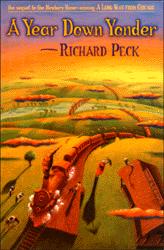 “A lot of fiction is about remembering better days.” The elder characters in Mr. Peck’s books are often patterned after the old men who frequented his father’s filling station in the 1930’s and 40’s. He recalls their conversations and makes “rough music out of real speech.” You can write in the voice of a young character, but have that young person know old people. Children want adults to be strong, but they often can’t find them.
“A lot of fiction is about remembering better days.” The elder characters in Mr. Peck’s books are often patterned after the old men who frequented his father’s filling station in the 1930’s and 40’s. He recalls their conversations and makes “rough music out of real speech.” You can write in the voice of a young character, but have that young person know old people. Children want adults to be strong, but they often can’t find them.
Years ago, the books in his school library were kept under glass and you had to find the teacher for a key. “Consider that metaphor,” he said. “The teacher has the key.” Book are still as precious, but it is up to the writer to make them so. “You can teach children or fear the parent, but you can’t do both. We are the last literature teachers left because we can’t be fired. We’re unemployed!”
Every week Mr. Peck visits the book store and spends an hour perusing first lines. “We live in the age of the sound byte, so you have to ‘byte’ them out front.” He recited the first line of Charlotte’s Web to remind us of its power: “Where’s Papa going with that axe?” Six words on one line ignite the imagination. And then he gave a fine example of voice with M.T. Anderson’s Feed: “We went to the moon to have fun but the moon turned out to completely suck.”
He always travels with a book from the past and a new book. The book from the past reminds him that we’re all links in a chain, while the new title keeps him tuned to what’s coming next. “If we don’t know what publishers are releasing this year, how will we get on next year’s list?” He’s reading Laurie Halse Anderson’s Wintergirls, “the greatest argument for writing in first person. It skates too near to the truth.”
Mr. Peck concluded by reminding us that “a story is always a question, never an answer. We can ask the questions that no one else will ask.” Story is the most important gift we can give our youth. Think about that 8th grade boy. “Story might be the companion that a child needs.”






 Children’s book writers were treated to another fun and informative first page session this week in Princeton, hosted by the NJ-SCBWI. Editors Michelle Burke and Allison Wortche of Knopf & Crown Books For Young Readers listened to 30 first pages read aloud as they followed along with each manuscript page. Then they gave their immediate first impressions of the work.
Children’s book writers were treated to another fun and informative first page session this week in Princeton, hosted by the NJ-SCBWI. Editors Michelle Burke and Allison Wortche of Knopf & Crown Books For Young Readers listened to 30 first pages read aloud as they followed along with each manuscript page. Then they gave their immediate first impressions of the work.
If you’ve never attended a first page critique, it’s a quick way to get a handle on what your peers are writing. A first page session shows you what it’s like for an editor to spend two hours in the slush pile. Common themes emerge. Mistakes reveal themselves. If you listen carefully, you’ll learn how to avoid first page problems and encourage an editor to read on.
So what did the editors say? I encourage you to read on…
Picture Books:
Use varying imagery in picture books. One manuscript conveyed a lot of emotion and the editors didn’t see where the illustrator would take inspiration for art. The same scene through several page turns may lose a child’s attention.
Dialogue needs to match the age of your character. A picture book character shouldn’t sound older than a five- or six-year-old child. Their actions should also match their age.
Cut excess detail in picture books. The first page of the manuscript should reveal a clear story arc. If the manuscript is bogged down with details, it slows the story down. For example, writing that a mother is carrying a napkin to the table and setting it down next to the plate is unecessary (unless that specific action is crucial to the story, and even so, it could probably be illustrated).
Premise and conflict should be apparent on the first page of a picture book manuscript. For example, dialogue between two characters should reveal a story, not just serve as adorable banter.
Every line in a picture book should move the story forward. There’s no room for chatting or extraneous stuff.
Picture books should have a linear approach. Moving back and forth in time can confuse a young child.
With holiday stories, you automatically have to work harder. Stories about specific times of year are a tough sell. There’s a lot of competition and a small sales window.
Some picture book stories are told better without rhyme. If the phrasing is unnatural in rhyme–things you wouldn’t ordinarily say–it can be jarring to the story. One bad line can ruin the manuscript’s chances.
Middle Grade/YA:
The narrator/main character should be the highlight of the first page. One manuscript began by describing a minor character as a way to compare/contrast the narrator. However, when that minor character disappeared from the rest of the page, the editors were confused. Was that comparison necessary to introduce the narrator?
Historial fiction should tell a story. The reader should get a sense of the main character first–how he/she is affected by historial details. Too much fact will bog the story down and lose the character.
Don’t be too reptitive in a novel–get on with the story. If a main character reveals the same thing over and over again on the first page, it feels overdone. Introduce a concept and then move on with the story; don’t circle back paragraph after paragraph.
A first person narrative should have more narrative than dialogue on the first page to take advantage of this device. Plus, the narrative voice and the dialogue voice should match (unless the disconnect is for a specific purpose).
Avoid the stereotypical whiny, displaced, unhappy middle-grade voice. More than one middle-grade manuscript began with a character learning that he/she had to move. The result was a whiny narrator who wasn’t necessarily likeable. Editors warned that they see a lot of the parents-uprooting-child theme, so to rise above the slush, consider a different approach.
Be cautious in stories with several important characters. It’s difficult to write a story with multiple characters because introducing them can sound like a laundry list. Reveal their personalities in a way that’s organic to the story. It also asks a lot of the reader, to keep track of several characters.
Watch tense. The switch from dialogue to narrative in one story felt very abrupt because the dialogue was in past tense and the narrative was in present.
The difference between MG and YA is edgy, gritty. If the main character’s personality feels innocent, the genre might be middle grade, not young adult.
Balance description and dialogue. Dialogue moves a story along fast. Description slows it down. Long stretches of each create a choppy storytelling rhythm.
Make descriptions specific, not generic. One story began with vague details that could be applied to almost any story setting. It wasn’t until further down on the page that the reader learned the unique time and place, something that attracted attention. The editors suggested moving that info higher up.
YA characters should be teenagers. College YA characters and those over the age of 19 can be a tricky sell. That moves the story into adult territory. YA readers need to relate to the characters, and 20+ seems like a lifetime away to a 15 year-old.
Finally, stories should be kid-friendly, not sprinkled with adult sensibilities. One of the editors warned, “this feels like it’s about kids rather than for them.” Don’t let a parental point of view creep into your writing–kids find that creepy.






Every SCBWI first-page session I’ve attended has had one thing in common: picture book manuscripts about new babies in the family. At least two or three are submitted each time. Editors and agents respond by warning new writers: “The market is saturated with mom-is-having-a-baby books. If you’re going to write about a new sibling, the idea must be unique to stand out.”
I remember a harsh moment. After reading the first page of a new baby tale, an editor said, “This isn’t special enough to continue.”
Daunting, isn’t it? Makes you want to toss your baby–err, your manuscript–out the window.
So when they say the idea has to be unique, what do they mean?
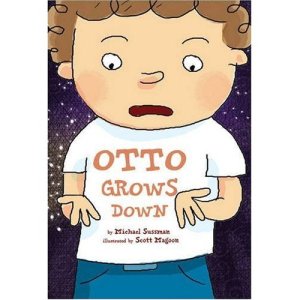 In a perfect world, they’d whip out Michael Sussman’s Otto Grows Down. Illustrated by Scott Magoon, it’s a tale of a boy who wishes his baby sister Anna was never born. “Be careful what you wish for” might be a cliché, but trust me, Otto Grows Down is an uncommon cautionary tale.
In a perfect world, they’d whip out Michael Sussman’s Otto Grows Down. Illustrated by Scott Magoon, it’s a tale of a boy who wishes his baby sister Anna was never born. “Be careful what you wish for” might be a cliché, but trust me, Otto Grows Down is an uncommon cautionary tale.
Otto makes his Anna-be-gone wish on his 6th birthday as he blows out the candles. Immediately, life begins to travel in reverse. Otto wraps up his gifts and hands them back to his friends. The second hand on his new watch ticks backward.
The next day at school, they start with mess-up time. Otto has a tough time getting used to sliding UP the slide, and he’s so tired at the end of the day, he just wants to eat breakfast and get to bed. And going to the bathroom? Nasty business. (Nasty, hysterical business to my kids.)
Otto’s parents soon return Anna to the hospital and she disappears. Otto rejoices. But strangely, time doesn’t move forward again, it just keeps unraveling. Otto celebrates his fifth birthday, his fourth, his third…and he realizes that he may disappear, too! He’s slowly losing the words he needs to make his new wish come true: OTTO BIG!
Call it a dark comedy for kids. Scott Magoon’s film noir feel strikes the right balance between humor and horror. Dark shadows and warm colors mimic Otto’s flip-flopping emotions. (And hey, did you notice all the character names are palindromes? Another cool touch, huh?)
I won’t tell you where it ends—or where it begins—but let me just say: every editor who sent Mr. Sussman a rejection probably wishes they could make time go in reverse, too.
 Otto Grows Down
Otto Grows Down
Story by Michael Sussman
Illustrated by Scott Magoon
Sterling, February 2009
Want it? Get it!
P.S. Author Heather Ayris Burnell interviewed Michael Sussman on her blog–plus she’s giving away a copy of the book!






Random comments on the children’s book industry from editors and agents attending the NJ-SCBWI mentoring workshop on February 22:
On THE ECONOMY:
“Things are getting tighter with budgets. As hard as it was to get published, it’s even harder now.”
“Bookstores are cutting down on their inventory. We can’t get as many books in, so we’re not buying as many books.”
“This is not just a correction of the marketplace, it’s a correction of the mind.”
“We’re going to be seeing far fewer advances for mediocre books.”
“But if you’re a new author, you don’t have a poor track record to hurt you.”
“We may see a return to house authors. Authors and publishers will enter a partnership. They’ll help nuture one another and careers will have a steady progression. If you find a house that loves you, they will love you long time!”
On MARKETING & PROMOTION:
“Learn how to market your books. Do school visits. Use social networking tools. Talk to other writers about your book. Talk to everyone about your book.”
“Get to know your publicist and marketing director. They are your friends. But don’t overwhelm them with 17 email messages a day. Let them know you’re their partner.”
“Realize that the books you see up front in the stores are paid for by the publishers through co-op marketing. If they have a talking slip? Paid for. If they’re on an end-cap? Paid for.”
“Become friends with your local librarian and your local bookstores. But always keep your publicist informed about what you’re doing. Don’t go over their head. Don’t go over your editor’s head, either. That’s bad business for everyone involved.”
“Don’t waste people’s time. Don’t send chocolate to all the Borders buyers in the country.”
“With school visits, you’re a celebrity to those kids. Get yourself out there. Build word-of-mouth.”
“Temper your expectations. If you wrote a teen non-fiction book, the big retailers aren’t going to carry it. That’s not their market.”
“Don’t follow today’s trends. Writing for the market in general is a terrible idea.”
“If you’re a picture book writer, don’t start writing a YA about vampires just because it’s popular.”
On EDITORS:
“Editors are always in the market for a well-written book. But I can’t define for you what that is. I know it when I see it.”
“Know what your editor likes. Know who you’re submitting to. I don’t like gross stories.”
“But I do! Send them to me!”
“We like authors who are agented because the work comes in polished.”























 I am so absolutely thrilled that
I am so absolutely thrilled that 


 Ever have one of those light-bulb moments when your manuscript finally gels? Your plot falls into place and you wonder why you didn’t think of something so simple and perfect before.
Ever have one of those light-bulb moments when your manuscript finally gels? Your plot falls into place and you wonder why you didn’t think of something so simple and perfect before. She’s the author of 11 picture books and 16 non-fiction books for children including
She’s the author of 11 picture books and 16 non-fiction books for children including  I also randomly got a foot in the door of children’s publishing by mentioning my science background in a cover letter. I’d sent a picture book manuscript to Sterling, which they rejected, but in the rejection the editor asked if I’d consider writing a science experiment book for them. That became Championship Science Fair Projects, which still sells really well for me, and a few years later, my first picture book, Tightrope Poppy, was published by the same editor.
I also randomly got a foot in the door of children’s publishing by mentioning my science background in a cover letter. I’d sent a picture book manuscript to Sterling, which they rejected, but in the rejection the editor asked if I’d consider writing a science experiment book for them. That became Championship Science Fair Projects, which still sells really well for me, and a few years later, my first picture book, Tightrope Poppy, was published by the same editor.



 “For all those who thought E.B. White was coming. Sorry, I’m the black one. As you can see, I’m not white and I’m not dead.”
“For all those who thought E.B. White was coming. Sorry, I’m the black one. As you can see, I’m not white and I’m not dead.” He gave us some background on his childhood. “When I visit schools, I tell the kids that I failed 3rd grade. It levels the playing field. ‘Wow, E.B. Lewis failed!’ the kids say.” The children immediately understand that if Mr. Lewis was able to become an artist, they, too, can reach their goals.
He gave us some background on his childhood. “When I visit schools, I tell the kids that I failed 3rd grade. It levels the playing field. ‘Wow, E.B. Lewis failed!’ the kids say.” The children immediately understand that if Mr. Lewis was able to become an artist, they, too, can reach their goals. Over the past 14 years, Mr. Lewis has illustrated 47 books at the rate of about 3/4 books a year. He has won the Coretta Scott King illustrator award four times. He won a Caldecott honor for Coming on Home Soon. He works with 14 different publishers and is currently booked through 2014. (That’s right, five years in advance. But I’m taking special note of the lucky number 14.)
Over the past 14 years, Mr. Lewis has illustrated 47 books at the rate of about 3/4 books a year. He has won the Coretta Scott King illustrator award four times. He won a Caldecott honor for Coming on Home Soon. He works with 14 different publishers and is currently booked through 2014. (That’s right, five years in advance. But I’m taking special note of the lucky number 14.)
 The first keynote presentation by Richard Peck, Newbery award-winning author of The Year Down Yonder, set a serious yet exciting tone for the conference. His unique voice extends beyond his books–when he speaks, he feels as big as a Shakesperean actor, filling the room, enunciating, using his entire body. (It was no surprise to learn that he belongs to a group of authors known as the “
The first keynote presentation by Richard Peck, Newbery award-winning author of The Year Down Yonder, set a serious yet exciting tone for the conference. His unique voice extends beyond his books–when he speaks, he feels as big as a Shakesperean actor, filling the room, enunciating, using his entire body. (It was no surprise to learn that he belongs to a group of authors known as the “ “A lot of fiction is about remembering better days.” The elder characters in Mr. Peck’s books are often patterned after the old men who frequented his father’s filling station in the 1930’s and 40’s. He recalls their conversations and makes “rough music out of real speech.” You can write in the voice of a young character, but have that young person know old people. Children want adults to be strong, but they often can’t find them.
“A lot of fiction is about remembering better days.” The elder characters in Mr. Peck’s books are often patterned after the old men who frequented his father’s filling station in the 1930’s and 40’s. He recalls their conversations and makes “rough music out of real speech.” You can write in the voice of a young character, but have that young person know old people. Children want adults to be strong, but they often can’t find them.
 Children’s book writers were treated to another fun and informative first page session this week in Princeton, hosted by the NJ-SCBWI. Editors Michelle Burke and Allison Wortche of Knopf & Crown Books For Young Readers listened to 30 first pages read aloud as they followed along with each manuscript page. Then they gave their immediate first impressions of the work.
Children’s book writers were treated to another fun and informative first page session this week in Princeton, hosted by the NJ-SCBWI. Editors Michelle Burke and Allison Wortche of Knopf & Crown Books For Young Readers listened to 30 first pages read aloud as they followed along with each manuscript page. Then they gave their immediate first impressions of the work.
 In a perfect world, they’d whip out Michael Sussman’s Otto Grows Down. Illustrated by Scott Magoon, it’s a tale of a boy who wishes his baby sister Anna was never born. “Be careful what you wish for” might be a cliché, but trust me, Otto Grows Down is an uncommon cautionary tale.
In a perfect world, they’d whip out Michael Sussman’s Otto Grows Down. Illustrated by Scott Magoon, it’s a tale of a boy who wishes his baby sister Anna was never born. “Be careful what you wish for” might be a cliché, but trust me, Otto Grows Down is an uncommon cautionary tale. Otto Grows Down
Otto Grows Down

I’m gonna be the PiBoIdMo light bulb balloon for Halloween.
Love it!
I’m so looking forward to PiBoIdMo this year, Tara. Also, I should be getting your book any day now. Woo Hoooooo! They didn’t have it at the bookstores in my area, so I ordered it online. Can’t wait to share it with my grandson!
Thank you, Tara! Happy 5th PbIdMo Anniversary!
Awesome!
5 years? Wow–congrats!! I’m a PiBoIdMo first-timer who might just be a little too enthusiastic about trying something new. Can’t wait to register!
This will be my first time participating. This month, I plan to read some picture books and get my picture book idea box and notebook ready.
LOL!
Looking forward to PiBoIdMo 2013!
Yay! So glad it’s time to harvest a whole crop of new ideas for next year! Can’t wait!
Sounds like it’s going to be another great November. Looking forward to it!